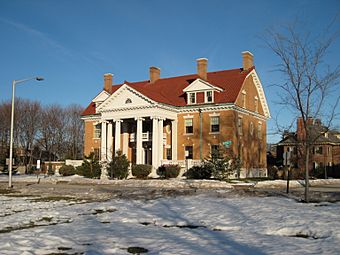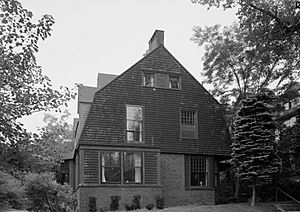Western Promenade Historic District facts for kids
The Western Promenade Historic District is a special neighborhood in the West End of Portland, Maine. It has many unique and beautiful homes built between the late 1800s and early 1900s. This area was once the most stylish place to live in Portland. Three famous architects, Francis H. Fassett, John Calvin Stevens, and Frederick A. Tompson, lived and worked here. This historic district was added to the National Register of Historic Places in 1984.
Contents
Exploring the Western Promenade Historic District
The Western Promenade Historic District covers a large area in Portland. It is known for its beautiful old homes. These houses show off many different building styles from the past.
A Look at the Neighborhood's History
Before the 1850s, most of Portland grew in the middle of the peninsula. The western part was quite wet and swampy. A man named J.B. Brown owned much of this land. In the mid-1850s, he built a large house called "Bramhall."
The city of Portland also helped shape the area. In 1836, the city created the Western Promenade, which is a public park. The Western Cemetery was also set up here in the late 1700s.
In the 1860s, Portland started to grow westward. J.B. Brown began to sell off parts of his land. He also helped drain the swampy areas. This made it possible for new homes to be built.
Famous Architects and Their Homes
Many important people bought land in this growing neighborhood. One of them was Francis H. Fassett. He was a leading architect in Portland during the second half of the 1800s. His own home is at 117–119 Pine Street. He designed many of the buildings you can see in the district.
Fassett also taught John Calvin Stevens, who became another famous architect. Stevens lived on Bowdoin Street. His house is a great example of the Shingle style of architecture. Stevens helped make this style very popular. You can find many of his designs throughout the area.
What You'll See in the District
The historic district is bordered by the Western Promenade to the west. Bramhall and Brackett Streets are to the north. Danforth Street is to the south. The eastern border is a bit uneven, including streets like Clark, Cushman, and Emery.
There are 420 buildings in this district. They show many different architectural styles popular between 1850 and 1920. You can see beautiful homes designed by architects in styles like Second Empire, Italianate, Queen Anne, Colonial Revival, and Shingle.
One special row of houses faces the Western Promenade. Among them is the Adam P. Leighton House. This is a beautiful Italianate mansion. It was designed by Frederick A. Tompson for Adam Leighton. Mr. Leighton was a Portland businessman and mayor. He is also known for inventing the postcard!





